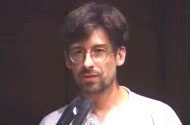 Open
Sources in Net Art Open
Sources in Net Art
So if we talk about open source software and what is called net art, of course there are similarities here and also differences. What are some of the differences? The aim of open source software perhaps is to create some product, some application that can be used for very practical purposes. But when we talk about art it's much more undefined. And, what's the use of art after all? Is it just the expression of somebody's individuality or anything else? I won't dare to define it. So that's why it is different from this open source question and open source distribution. If we talk about open source ideology in art and specifically in net art I think we should devide it in two parts. The first one is the code itself. The code that you can grab from webpages or the code that you can find in CGI archives and just use it, and also free software that you can use for the development of your project. But this, I think, is not as important as the second one, which is the opening of sources of information. I think this is very crucial, especially in art, because so far, what is called the contemporary art system was based on the vertical and hierarchical system of distribution of information. So those who are on the top of this pyramid have all information and they maintain their power by keeping this information and the right-of-way of distribution. So in a career of an artist, the artwork itself has become less important than the promotional techniques of that artist, and his or her access to those who have power and information. During the history of contemporary art there were a few attempts to break this. We can recall the Dada movement or Fluxus or others. But in the end, all of these movements were appropriated by the system. They couldn't change it. So far, we just have nice recollections and museum pieces made out of those radical projects. Actually it is very basic information in many cases, like what is going on, which event is taking place, where and when, and who is in charge, who is the contact person, how to submit the project and where to get money, things like this. This is essential information that would support an artist in his or her activity. Most of this information is still hidden, but with the emergence of the Internet some information has become accessible. I want to mention here some of the mailinglists. If we talk about art I think the most important are Syndicate and also Rhizome. And then I would also like to mention the mailinglist Nettime that is used for distribution of that kind of information and for bringing people together and encouraging collaborative projects. Maybe now I show some practical
examples of artwork that you can find on the Internet and that has something
to do with that open source ideology. The first one is, of course, a site
by the group called jodi.org. I think
they were pioneers in net art. They started to work with browsers right
after Mosaic came out. They still are, to my mind, some of the most interesting
artists especially because of their ideology. In what they are doing they
don't invent anything, they just use appropriated stuff. They make an extensive
search on the Internet and grab whatever they find interesting, and then
play with it, and see what they can do.
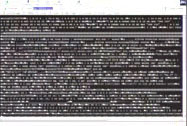 I want show one of the projects.
I think it is based on some easy and simple script they found somewhere
in an archive. The idea is that you submit something and then the data
is beeing processed and as a result, as an output you see something, you
know, something that has something to do with art, definitly. I think it
is very interesting because we live in the age of excessiv information,
and all attempts of artists to tell newer and newer stories, to attract
more and more attention to their individuality, to their reflections on
what is going on, to my mind, are much less interesting than certain information
that you can -- if you look precisly -- grab from all the streams that
surround us.
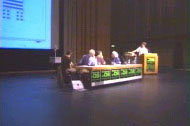 ... and so on. And of course
you can also look at the source and see how it is made. When I did this
project I though: OK, I've invented a new art form. It would be fair to
give it to people and open the source. I got an idea that I have to encourage
artists all over the world to work with this medium that I have invented.
And then I announced an international competion of this format. And there
were a lot of submissions, and actually it worked pretty well. There were
quite many entries. So people really liked the idea, and of course, there
was a money price in this competition. In a way it was a joke on the existing
system of competitions in art where some jury people have to select who
is the best and who is not. This project was my critical comment on that.
Everything was made by just myself. I invented the artform, I made the
website and I was the only jury member. I was honest, you know. I think
I selected the best. Nobody complained, acutally.
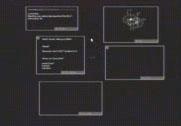 The next project which I want
to show is quite revolutionary because it is a piece of software that you
should download and moreover it is a browser, the Web
Stalker. This is made by artists from Britain, a group called I/O/D.
Here you see the interface of this browser. It doesn't look familiar. Now
we need some windows... Open a URL... That will be the ars electronica...
And now you see the source is coming. This browser shows the poetry of
the open source, actually. What does it do? It is completely dysfunctional.
It goes to the URL that you point it to and then follows all the links
going from the front page, and shows the html-code of each page and also
the connections of this hyperlink system. And here you see the URL which
is beeing processed. You can change colores. By certain opinions, this
was the end of net art, because artists created the final product, the
browser for themselves. What is interesting about this very project is
that it was donated by the artist as an artwok to the City of Manchester.
And another thing is that they don't open the source of this software,
at least, it is not available on their webpage, but I think nobody asked
them for it. Because it is the final product and if you get the final source
what would you do? You'd rather create your own artwok. And here I also
see the difference with the development of open source software because
with artistic work what is important is not the source of it, but the idea
that is behind it, and OK, you can open it but the idea is obvious. What
can you do with that?
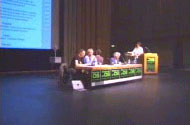 One other project which has something to do with the possibility to see sources and to grab sources and also the copyright issue is the project by Vuk Cosic from Slovenia. It is called documenta down. You probably know that there is a big art fair in Germany called Documenta which is happening every four years and is the most prestigious art show in Europe, at least. For the last one they made a website and put some of the web or Internet art projects on the site. It was up from June to September 1997. It had a lot of projects in it. And the URL was documenta.de. But they decided to stop the site at a certain point in September. A few days before they did it Vuk just grabed most of the site -- of course, he couldn't get it all, it has some CGI scripts on it -- and put it on his site. You see the changed URL: vuk.org/dx. It caused some scandal, I have to say, because the copyright issues in this case are not really defined. Whether he can do it or not is not clear. So he just did it and became famous through that. To conclude I would like to
recall the question that Tim O'Reilly posed yesterday: Who is going to
become the Microsoft of the open source? Actually I could also pose a similar
question: Who is going to become the Microsoft of net art in the near future?
Because the problematic is very similar, and I have to say that there are
certain attempts at it. We will just have to see if it happens or not.
(Transkription
Katja Pratschke)
|